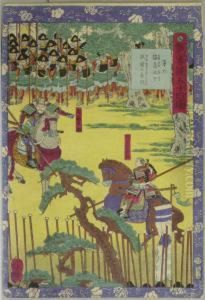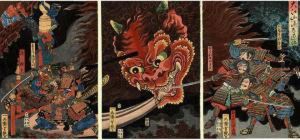Utagawa Ichieisai Yoshitsuya Paintings
Utagawa Ichieisai Yoshitsuya, also known as Kōka Yoshitsuya, was a Japanese ukiyo-e artist born in 1822, during the late Edo period. He was a student of the renowned Utagawa Kuniyoshi, one of the last great masters of the ukiyo-e genre of woodblock prints and paintings. Ukiyo-e, which translates to 'pictures of the floating world,' refers to a genre of Japanese art that flourished from the 17th through 19th centuries and typically depicted scenes from history, theatre, and the pleasure quarters of Edo (modern-day Tokyo).
Yoshitsuya's works are known for their dynamic composition and vivid detail, often drawing inspiration from military tales, historical events, and warrior ethos. He was particularly adept at musha-e (warrior prints) and was also known for his depictions of animals and supernatural creatures, showcasing his versatility and imagination. His series on the '108 Heroes of the Suikoden' (a Chinese novel popular in Japan) is an example of his skillful adaptation of literary subjects.
Despite the popularity of his prints, Yoshitsuya's life was marked by the tumultuous times leading up to the Meiji Restoration, a period that saw the end of the shogunate and the restoration of imperial rule in Japan. This era of modernization brought about a decline in the traditional ukiyo-e market. Nevertheless, Yoshitsuya continued to produce work that resonated with the samurai class and those nostalgic for the days of old Japan.
Yoshitsuya passed away in 1866, leaving behind a legacy of intricate and powerful images that captured the spirit of his time. His work continues to be appreciated for its technical excellence and its reflection of the cultural and societal shifts of late Edo Japan. Although not as well-known as some of his contemporaries, Yoshitsuya's contributions to the ukiyo-e movement remain significant in the history of Japanese art.

